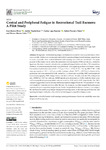Mostrar o rexistro simple do ítem
Central and peripheral fatigue in recreational trail runners: A pilot study
| dc.contributor.author | Varela-Sanz, Adrián | |
| dc.contributor.author | Muñoz-Pérez, I | |
| dc.contributor.author | Lago-Fuentes, Carlos | |
| dc.contributor.author | Navarro Patón, Rubén | |
| dc.contributor.author | Mecías Calvo, Marcos | |
| dc.date.accessioned | 2023-03-23T14:51:08Z | |
| dc.date.available | 2023-03-23T14:51:08Z | |
| dc.date.issued | 2023 | |
| dc.identifier.citation | Muñoz-Pérez, I.; Varela-Sanz, A.; Lago-Fuentes, C.; Navarro-Patón, R.; Mecías-Calvo, M. Central and Peripheral Fatigue in Recreational Trail Runners: A Pilot Study. Int. J. Environ. Res. Public Health 2023, 20, 402. https:// doi.org/10.3390/ijerph20010402 | es_ES |
| dc.identifier.issn | 1660-4601 | |
| dc.identifier.uri | http://hdl.handle.net/2183/32753 | |
| dc.description.abstract | [Abstract]: Background: Understanding fatigue mechanisms is crucial for exercise performance. However, scientific evidence on non-invasive methods for assessing fatigue in trail running competitions is scarce, especially when vertical kilometer trail running races (VK) are considered. The main purpose of this study was to assess the autonomic nervous system (ANS) activity (i.e., central fatigue) and the state of muscle activation (i.e., peripheral fatigue) before and after a VK competition. Methods: A cross-sectional pilot study was performed. After applying inclusion/exclusion criteria, 8 recreational male trail runners (31.63 7.21 yrs, 1.75 m 0.05 m, 70.38 5.41 kg, BMI: 22.88 0.48, running experience: 8.0 3.63 yrs, weekly training volume: 58.75 10.35 km) volunteered to participate and were assessed for both central (i.e., via heart rate variability, HRV) and peripheral (via tensiomyography, TMG) fatigue before and after a VK race. Results: After the VK, resting heart rate, RMSSD (p = 0.01 for both) and SDNN significantly decreased (p = 0.02), while the stress score and the sympathetic-parasympathetic ratio increased (p = 0.01 and p = 0.02, respectively). The TMG analyses suggest that runners already suffered peripheral fatigue before the VK and that 20–30 min are enough for muscular recovery after the race. In summary, our data suggest that participants experienced a pre-competition fatigue status. Further longitudinal studies are necessary to investigate the mechanisms underlying fatigue during trail running races, while training periodization and tapering strategies could play a key role for minimizing pre-competition fatigue status. | es_ES |
| dc.language.iso | eng | es_ES |
| dc.publisher | MDPI | es_ES |
| dc.relation.uri | https:// doi.org/10.3390/ijerph20010402 | es_ES |
| dc.rights | Atribución 3.0 España | es_ES |
| dc.rights.uri | http://creativecommons.org/licenses/by/3.0/es/ | * |
| dc.subject | Vertical kilometer | es_ES |
| dc.subject | Trail running | es_ES |
| dc.subject | Running performance | es_ES |
| dc.subject | Heart rate variability | es_ES |
| dc.subject | Muscular fatigue | es_ES |
| dc.subject | Tensiomyography | es_ES |
| dc.title | Central and peripheral fatigue in recreational trail runners: A pilot study | es_ES |
| dc.type | info:eu-repo/semantics/article | es_ES |
| dc.rights.access | info:eu-repo/semantics/openAccess | es_ES |
| UDC.journalTitle | International Journal of Enviromental Research and Public Health | es_ES |
| UDC.volume | 20 | es_ES |
| UDC.issue | 402 | es_ES |
Ficheiros no ítem
Este ítem aparece na(s) seguinte(s) colección(s)
-
GI-PHG - Artigos [101]






